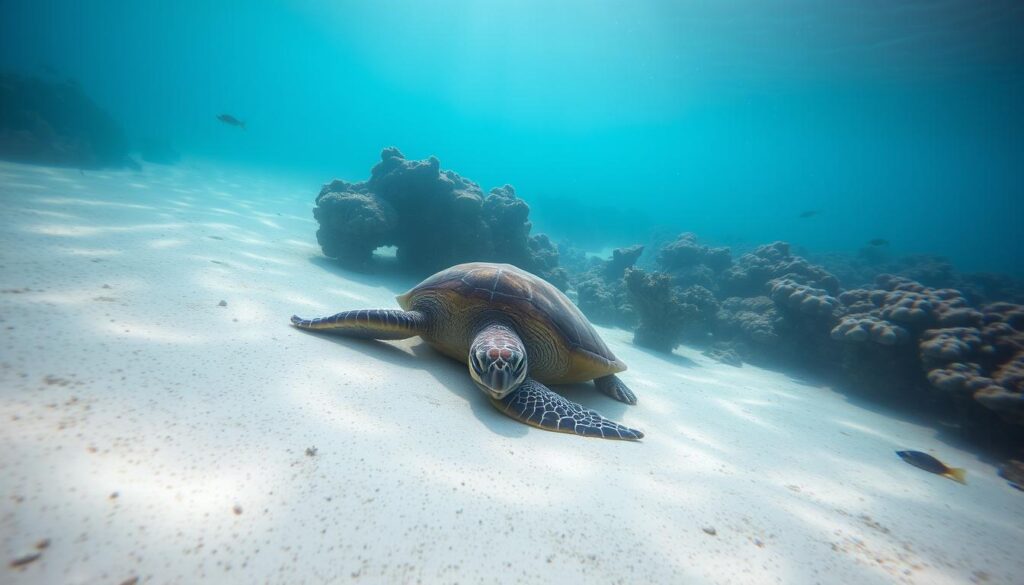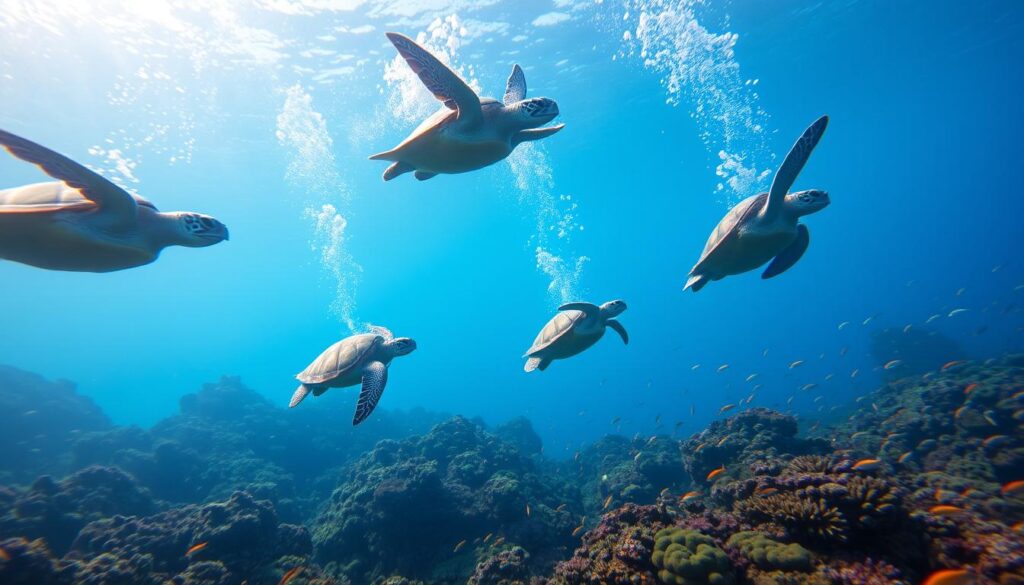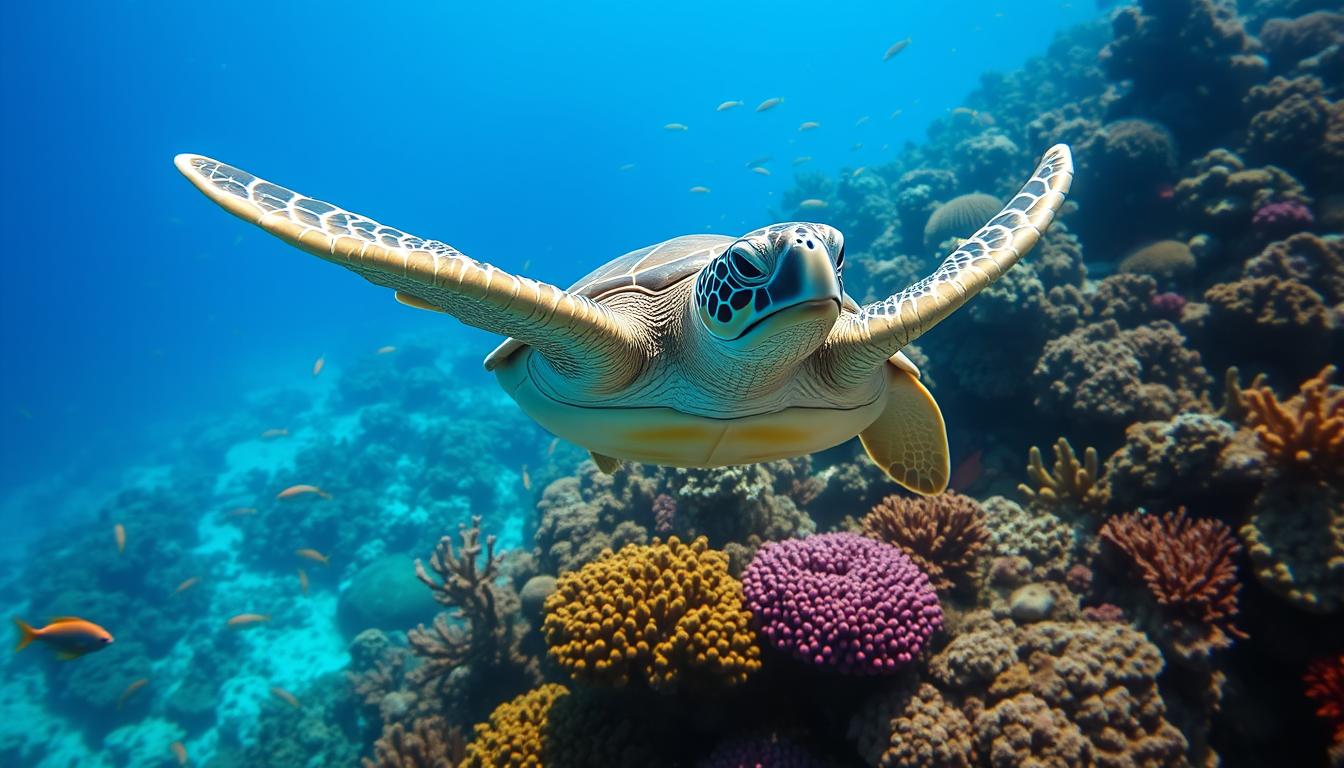Sea turtles can hold their breath for a long time underwater. They can stay submerged for up to 45 minutes to an hour. They only come up briefly every 6 minutes to breathe before diving again.
When they’re stressed, sea turtles can breathe faster. This lets them get back to the surface quicker to refill their lungs.
Turtles don’t just dive briefly. They can even sleep underwater for hours. They sleep for 4 to 7 hours before needing air. Their heart rate slows down to just one beat every 9 minutes.
Table of Contents
Understanding Sea Turtle Breathing Mechanisms
Sea turtles have evolved amazing ways to live in the ocean. Their lungs are special, helping them breathe underwater for a long time. This lets them stay underwater for hours.
Specialized Lung Structure
Sea turtles have lungs that are different from others. Their lungs hold a lot of oxygen. They also have special muscles that help them use oxygen better.
Oxygen Storage Capacity
Sea turtles can hold a lot of oxygen in their blood and muscles. This lets them dive deep and stay underwater for a long time. They use oxygen very efficiently.
Respiratory System Adaptations
Sea turtles have lungs that work well even when there’s little oxygen. They can get oxygen into their blood easily. This helps them breathe while they’re diving.
Some sea turtles can even breathe through their cloaca. This is a special way to get oxygen while they’re underwater.
“Sea turtles’ remarkable respiratory adaptations are a testament to their evolutionary success in the marine environment.”
Sea turtles have special lungs and ways to breathe underwater. These features help them live well in the ocean. They are amazing and strong creatures.
How Long Can a Sea Turtle Hold its Breath?
Sea turtles are known for their amazing ability to stay underwater for a long time. They have special ways to save oxygen and stay alive without air for a while.
When they’re just swimming around, sea turtles can hold their breath for 45 minutes to an hour. They usually come up for air every 6 minutes. But, if they’re stressed, they need to breathe faster.
Sea turtles sleep underwater, holding their breath for 4 to 7 hours. Their heart beats very slowly, just once every 9 minutes. This is much slower than a human’s heart.
“Some sea turtles can remain submerged for an extended period during sleep, with the current record for a leatherback sea turtle holding its breath underwater standing at a little over 7 hours.”
This turtle breath-holding record shows how well sea turtles can stay underwater. Their special skills help them save energy, find food, avoid dangers, and rest underwater for a long time.
Even though sea turtles can stay on land for a bit, they mostly live in the sea. The sea helps them stay hydrated, keeps them cool, and protects them from predators. Staying on land for too long is not good for them.
Remarkable Physiological Adaptations of Sea Turtles
Sea turtles have amazing ways to live in the ocean. They can control their heart rate, blood flow, and how they use energy. This helps them hold their breath for a long time and dive deep.
Bradycardia and Heart Rate Control
When diving, sea turtles slow down their heart rate a lot. Leatherback turtles, for example, can slow their heart to just 3.6 beats per minute for 34 minutes. They can even slow it down to almost stop, saving oxygen.
Blood Flow Regulation
Sea turtles use a trick to keep their blood flow right. They send blood to the heart and brain, not to other parts. This helps them use oxygen better and hold their breath longer.
Metabolic Rate Adjustments
Sea turtles use oxygen slowly, which helps them dive longer. They can adjust how they use energy to stay underwater. This is key to their amazing ability to hold their breath.
“Sea turtles can hold their breath for extended periods while swimming, feeding, and sleeping below the waves.”
These special ways help sea turtles dive and stay underwater for a long time. Learning about these adaptations shows how amazing and resilient these marine reptiles are.
Temperature’s Impact on Breath-Holding Duration
Water temperature greatly affects how long sea turtles can hold their breath. In cooler waters, their body works slower. This means their heart rate, breathing, and energy use go down. They can stay underwater for a long time, sometimes over an hour.
But, if the water gets too cold, sea turtles can get very tired. This is called “cold-stunning.” It makes it hard for them to swim and increases the chance they’ll get stranded.
Some sea turtles, like the leatherback, can handle colder water better than others. The leatherback sea turtle dives really deep, over 3,900 feet. This shows how well it’s adapted to the deep sea.
| Sea Turtle Species | Breath-Holding Duration | Adaptations to Cold Water |
|---|---|---|
| Leatherback | Up to 85 minutes | Excellent cold-water tolerance |
| Green | Hours during migrations and feeding | Moderate cold-water tolerance |
| Hawksbill | Impressive dive times | Moderate cold-water tolerance |
| Kemp’s Ridley | 15 to 30 minutes | Lower tolerance for cold water |
The amazing sea turtle thermoregulation and cold-water diving adaptations help them survive. These traits are key for their success in different marine environments.
Different Species, Different Capabilities
Sea turtles can hold their breath for varying lengths of time, depending on the species. Each has special traits that help it dive and stay underwater. Let’s look at the amazing abilities of three sea turtle species.
Leatherback Turtle Diving Records
The leatherback turtle is the deepest-diving sea turtle. It can dive over 1,000 meters (3,280 feet) deep. It stays underwater for up to 85 minutes.
Its big body and lungs let it hold more oxygen. It can handle the deep ocean’s pressure.
Green Turtle Underwater Endurance
Green turtles are known for staying underwater for long periods. They can sleep underwater for 4 to 7 hours. Then, they quickly come up for air.
They can slow down their heart rate and blood flow. This helps them save energy and oxygen while sleeping underwater.
Loggerhead Turtle Breath-Holding Abilities
Loggerhead turtles can hold their breath for a long time. One was recorded staying underwater for 7 hours in winter. They slow down their metabolism and blood flow to save oxygen.
Each sea turtle species has its own special ways to dive and hold its breath. Knowing these differences helps us see how amazing and diverse these ancient sea creatures are.
| Sea Turtle Species | Maximum Dive Depth | Maximum Breath-Hold Duration |
|---|---|---|
| Leatherback Turtle | Over 1,000 meters (3,280 feet) | Up to 85 minutes |
| Green Turtle | Not Reported | 4 to 7 hours (while resting) |
| Loggerhead Turtle | Not Reported | Over 7 hours (during winter) |
Sleep and Resting Underwater Behaviors
Sea turtles are amazing creatures that can sleep underwater for hours. They can hold their breath for 4 to 7 hours while resting. Their heart rate slows down, sometimes beating only once every nine minutes.
This special ability helps them save energy. It’s important for their survival in the ocean, where they spend most of their time.

Sea turtles have evolved to rest underwater for long periods. They have unique ways to conserve energy. This lets them thrive in the vast ocean.
| Sea Turtle Species | Underwater Rest Duration |
|---|---|
| Leatherback | 7+ hours |
| Green | 4-6 hours |
| Loggerhead | 5-7 hours |
| Hawksbill | 4-6 hours |
The table shows that bigger sea turtles can rest underwater longer. This is a key part of their survival in the ocean.
Survival Mechanisms in Cold Waters
Sea turtles face tough conditions when they go into cold waters. But they have amazing ways to stay alive. Their ability to adapt to cold is truly impressive.
Winter Adaptation Strategies
Some sea turtles, like the painted turtle, can live in icy water for up to five months. They slow down their heart and metabolism a lot. Sometimes, their heart beats only once every 10 minutes.
In winter, some turtles go to the bottom and barely move. They get very little oxygen through their skin. This lets them hibernate under ice for a long time without needing air.
Metabolic Slowdown Process
Sea turtles’ secret to surviving cold water is slowing down their body’s functions. This helps them save energy and live longer without much oxygen. Their unique adaptation lets them live in cold places where others can’t.
Cold Water Survival Techniques
- Reducing heart rate and metabolism to conserve energy
- Sinking to the seafloor and remaining nearly motionless to minimize oxygen consumption
- Absorbing oxygen through their skin to supplement limited respiratory function
- Exhibiting increased cold tolerance and the ability to withstand freezing temperatures
Sea turtles have amazing ways to survive in cold water. They show how adaptable these ancient creatures are.
| Species | Cold Water Survival | Metabolic Slowdown |
|---|---|---|
| Leatherback Turtle | Can tolerate colder waters better than other sea turtle species | Lowers metabolism and heart rate to conserve energy |
| Green Turtle | Capable of spending extended periods in cooler waters | Reduces activity levels and metabolic processes to adapt |
| Loggerhead Turtle | Exhibits behavioral adaptations to survive in cold environments | Employs physiological mechanisms to slow down metabolism |
Sea turtles’ ability to live in cold water is amazing. Their survival strategies and slow metabolism show their incredible adaptability and resilience.
Diving Depths and Duration Correlation
The depth of a sea turtle’s dive often matches its duration. Deeper dives take longer because of the energy needed to go up and down. Leatherback turtles, known for their deep dives, can dive over 1,000 meters and stay underwater for a long time. The link between dive depth and duration changes among species. It depends on water temperature, food availability, and the turtle’s health.
The largest turtle, the leatherback, can grow up to 2.7 meters long and weigh over 500 kilograms. On the other hand, the smallest turtle, the Chersobius signatus from South Africa, is only 10 centimeters long and weighs 172 grams. These size differences affect how well different sea turtles can dive.
| Sea Turtle Species | Maximum Dive Depth (meters) | Maximum Dive Duration (minutes) |
|---|---|---|
| Leatherback Turtle | 1,230 | 86.5 |
| Green Turtle | 300 | 66.5 |
| Loggerhead Turtle | 233 | 54.0 |
The sea turtle dive profiles show their amazing physical adaptations. As we learn more, we’ll understand better how their diving abilities work. This knowledge will help us protect these ancient sea creatures.

Conservation Implications for Breath-Holding Ability
Sea turtles can hold their breath for a long time, but they can drown quickly if caught in fishing gear. This is why turtle excluder devices were created. They help prevent sea turtles from getting caught in shrimp nets.
Sea turtles can hold their breath for 15 to 30 minutes while swimming. But when they rest underwater, especially in cooler waters, they can stay submerged for hours. This is important to know for their conservation.
To protect sea turtles, we need to protect their nesting sites and reduce bycatch. We also need to clean up marine debris. By understanding how long sea turtles can hold their breath, we can better protect them.
| Breath-Holding Ability | Duration |
|---|---|
| Typical Dives | 4 to 5 hours |
| Maximum Underwater Resting/Sleeping | Up to 7 hours |
| Active Swimming or Foraging | 15 to 30 minutes |
Sea turtles’ ability to hold their breath is key to their conservation. By knowing their limits, we can protect them better. This ensures their survival for years to come.
“Protecting nesting sites, reducing bycatch, and mitigating marine debris are crucial steps in safeguarding sea turtle populations.”
Conclusion
Sea turtles can hold their breath for a long time, showing their amazing physical changes over millions of years. They have special lungs and ways to use oxygen that help them live in the sea. Research on sea turtles helps us learn more about them and how to protect the ocean.
Learning about sea turtles’ ability to stay underwater helps us protect them. This knowledge helps us make better plans to save these important animals. It also might help us in the future, like in medicine and exploring the deep sea.
By studying sea turtles, we learn a lot about the ocean and how to take care of it. This research is key for protecting marine life and for our future. It shows us how important it is to study sea turtles and protect the ocean.

